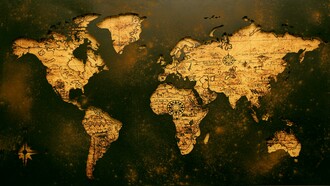Since the beginning of the 21st century, the tightening of migration policies both within and beyond EU borders attempts to hinder migrants' clandestine crossings through increased border surveillance and international agreements between EU and non-EU countries. The implementation of migratory restrictions and refoulement operations at sea have turned the Mediterranean Sea into a dangerous space for the crossing of the precarious vessels used to reach Europe. The expulsion machine in response to clandestine migration has forced migrants to choose even more perilous routes, strengthened their reliance on human traffickers, and inevitably caused an increase in fatal crossings across the Mediterranean Sea.
Migratory phenomena across the Mediterranean Sea have led to a proliferation of literary productions scrutinizing different aspects of clandestine migratory practice on the European shores. This body of work narrates the recent transformations of migratory patterns, the causes of contemporary African migration to Europe, and the plight of migrants. The fact that many authors write about the current migration across the Mediterranean Sea is significant of a shared sensibility about the urgency of this issue.
Bordering the Mediterranean Sea: geopolitics and aesthetics
The physical characteristics—fluidity and mutability—of the sea both encourage mobility and create friction, complicating the boundaries between dwelling and staying. While a border on land may be solidified and thus visible through the construction of a wall, borders at sea are less obvious, less visible, which does not mean less dangerous or less powerful. In this article, I will be focusing on a particular rhetorical figure associated with the Mediterranean Sea and used by some literary writers to describe the characters' encounter with the sea during the clandestine crossing. This figure is that of the maritime wall.
The sea as a transparent wall
In Catozella's Non dirmi che hai paura (2014) [Don't tell me you are afraid (2016)], the protagonist during the border crossing compares her situation to a running race where “[she] runs up against a transparent wall” (221-2), which impedes her from going any further. The rhetorical analogy of the transparent wall negates/counteracts the understanding of the sea as a topographical expanse to be crossed, a point of passage on the way to points of landing, a border bridge. Rather, it consists of a translucent border with a peculiar epistemological dimension—the border is transparent and invisible—that represents a power relationship and a form of exclusion. In this light, the transparent wall allows the characters to imagine reaching their destination but prevents them from actually moving forward. Although the border cannot be seen and its geopolitical level cannot be located, its epistemological level (between the known and the unknown) is accentuated: it functions as an invisible space that divides and creates distance, emphasizing its invisible but dominant power. The maritime border is transparent, so the eye can cross it, even if the migrants themselves cannot.
The maritime wall as a form of exclusion
Another literary production that employs the figure of the Mediterranean border as a wall is the novel by Louis-Philippe Dalembert, whose title is indeed Mur Méditerrannée (2019) [The Mediterranean Wall (2022)]. The novel recounts the migratory experience of a group of migrants who embark on a vessel off the coast of Libya in order to reach Lampedusa. The crossing of the Mediterranean Sea is fraught with danger and risk, primarily due to the poor quality of the vessel and the enforcement of border controls that prevent migrants from actually reaching European shores. The actions taken by EU border controls to impede the crossing have as a primary objective the construction of an obstructive line:
Their dream was to erect a wall in the Mediterranean in order to block the way for Muslim invaders from the south, as was already done in other regions of the world which cared about their own citizens. According to their spokesperson, there was nothing utopian about it. You just had to want it. Furthermore, the construction of such a technological marvel would serve to demonstrate the superiority of European civilization over others.1 (214).
The figure of the border wall is directly linked to the politics of exclusion and reflects a geopolitical imagination rooted in the conception of Europe as a fortress. Furthermore, it emphasizes the goal of the maritime border: to contain the familiar and exclude the others. The border figure of the maritime wall reinforces the perception that the two sides of the border are two separate universes. This implies that the preconditions and prefigurations, whether ideological concepts or imaginaries, are the primary factors that facilitate the formation of material borders. Without these intangible preconditions, a wall is simply a wall. In other words, no border can function without a corresponding border mentality.
The Mediterranean border: a self-destructive overreaction to exclusion
One additional novel that develops the concept of constructing a wall to protect the inside from the outside is Cavalli's Carnaio (2018) [Carnage]. Carnage is a dystopian novel that opens with a disturbing and unsettling scene: a fisherman fishing “a corpse from the other side of the sea... not a corpse from our world”2(11). The novel's incipit is set at sea, in an interstitial space where the quest for national and/or European identity is at its core. The initial discovery of a corpse by the fishermen marks the advent of a "fleshy wave" originating from the "bastard sea" that subsequently inundates the city (69–70). In response to this influx of corpses, the town, designated simply as "DF" throughout the novel, initiates spatial border control measures to address the pervasive sense of insecurity and the concomitant right to fear (21, 30). A wall is constructed around the city, yet the desire for an ideal, enclosed community persists. Consequently, a glass cupola is erected over the city, creating an enclosed and hermetic space. This is intended to provide a sense of security, yet it is ultimately an illusion. The construction of the wall and the cupola is a consequence of the reverse desire for protection, namely fear. Any practice of demarcating, selecting, and including produces its own fear, namely for what is excluded. The ambition of being completely isolated and walled in leads, however, to self-destruction. As the final passage of the novel states, “in five days everybody died, and as soon as the last one died, even the wave of those [corpses] stopped”[3] (217-218).
The final sentence of the novel highlights the regressive impetus to construct and spread impenetrable borders, both in their material aspects and in their imaginative figurations. This is not a sign of power but of weakness and even of self-destruction. In their supposed spectacle of strength, the impassable borders are the image of the sovereign power in the face of its downfall. Moreover, these borders serve to reinforce the false perception of a homogeneous and unified community on each side. They also perpetuate the misleading idea of preserving the "inside" from any contamination from a threatening "outside."
The pluriverse Mediterranean Sea
The three examples I have chosen to analyze the figure of the Mediterranean border as a wall and its consequences on the lives of migrants cannot be reduced to the simple depiction of discourses on clandestine migration across the sea. Rather, they must be acknowledged as a means of amplifying these discourses, as well as questioning or even destabilizing predominant paradigms. Furthermore, they posit that any border is a composite of images that are transformed into beliefs, which are then materialized into violent practices of exclusion. Since any border must be imagined into being before it becomes meaningful, the way we perceive and act in relation to it determines its materialization. Indeed, the maritime border is not produced by perceptions of its dimensions but by the imaginings of what it is and, especially, by discourses of what the sea is, is supposed to be, or must be made to be. It is fundamental that we do not reify the Mediterranean border wall by presuming it is simply a given. Rather, the border becomes given as a consequence of the repetition of bordering decisions and practices made over time. In other words, no border functions without a matching border mentality. The current rigidity of systems and models imposed on the Mediterranean Sea necessitates reconfiguration in order to accommodate the pluriverse Mediterranean. This entails abandoning a discourse sustained by a unilateral perspective and a unique chronology and substituting it with multifocal ones. The contemporary framing of the Mediterranean Sea as an insurmountable border should not be considered an enduring state of affairs. Rather, it should evolve into a threshold and a dwelling space.
References
1 My own translation. The original is the following: “Leur rêve était d'ériger un mur en Méditerranée pour barrer la route aux envahisseurs musulmans du Sud, comme cela se faisait déjà dans d'autres régions du monde qui avaient plus à coeur l'avenir de leurs citoyens. Selon leur port-paorle, cela n'avait rien d'utopique. Il suffisait de le vouloir. En plus, une telle prouesse technologique démontrerait la supériorité de la civilisation européenne sur les autres” (Dalembert 2019, 214).
2 My own translation. The original is the following: “un morto dall'altra parte del mare […] non un cadavere del nostro mondo” (11).
3 “In cinque giorni tutti morirono e quando morì anche l'ultimo, le onde di quelli [dei cadaveri] terminarono” (217-8).
4 Catozzella, Giuseppe (2016 [2014]). Don't tell me you are afraid, Appel Anne Milano transl., New York: Penguin Press.
5 Cavalli, Giulio (2018). Carnaio, Rome: Fandango.
6 Louis-Philippe (2019). Mur Méditerranée, Paris: Sabine Wespieser Ed.















